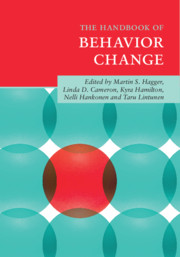Book contents
- The Handbook of Behavior Change
- The Handbook of Behavior Change
- Copyright page
- Dedication
- Contents
- Figures
- Tables
- Sidebars
- Contributors
- 1 Changing Behavior: A Theory- and Evidence-Based Approach
- Part I Theory and Behavior Change
- Part II Methods and Processes of Behavior Change: Intervention Development, Application, and Translation
- 19 Design, Implementation, and Evaluation of Behavior Change Interventions: A Ten-Task Guide
- 20 Moving from Theoretical Principles to Intervention Strategies: Applying the Experimental Medicine Approach
- 21 Developing Behavior Change Interventions
- 22 Evaluation of Behavior Change Interventions
- 23 Implementation Science and Translation in Behavior Change
- 24 Engagement of Stakeholders in the Design, Evaluation, and Implementation of Complex Interventions
- 25 Maximizing User Engagement with Behavior Change Interventions
- 26 Cost-Effectiveness Evaluations of Behavior Change Interventions
- 27 Addressing Underserved Populations and Disparities in Behavior Change
- 28 Behavior Change in Community Contexts
- 29 Changing Behavior in the Digital Age
- 30 Critical and Qualitative Approaches to Behavior Change
- Part III Behavior Change Interventions: Practical Guides to Behavior Change
- Index
- References
22 - Evaluation of Behavior Change Interventions
from Part II - Methods and Processes of Behavior Change: Intervention Development, Application, and Translation
Published online by Cambridge University Press: 04 July 2020
- The Handbook of Behavior Change
- The Handbook of Behavior Change
- Copyright page
- Dedication
- Contents
- Figures
- Tables
- Sidebars
- Contributors
- 1 Changing Behavior: A Theory- and Evidence-Based Approach
- Part I Theory and Behavior Change
- Part II Methods and Processes of Behavior Change: Intervention Development, Application, and Translation
- 19 Design, Implementation, and Evaluation of Behavior Change Interventions: A Ten-Task Guide
- 20 Moving from Theoretical Principles to Intervention Strategies: Applying the Experimental Medicine Approach
- 21 Developing Behavior Change Interventions
- 22 Evaluation of Behavior Change Interventions
- 23 Implementation Science and Translation in Behavior Change
- 24 Engagement of Stakeholders in the Design, Evaluation, and Implementation of Complex Interventions
- 25 Maximizing User Engagement with Behavior Change Interventions
- 26 Cost-Effectiveness Evaluations of Behavior Change Interventions
- 27 Addressing Underserved Populations and Disparities in Behavior Change
- 28 Behavior Change in Community Contexts
- 29 Changing Behavior in the Digital Age
- 30 Critical and Qualitative Approaches to Behavior Change
- Part III Behavior Change Interventions: Practical Guides to Behavior Change
- Index
- References
Summary
Rigorous evaluation of interventions is vital to advance the science of behavior change and identify effective interventions. Although randomized controlled trials (RCTs) are often considered the “gold standard”, other designs are also useful. Considerations when choosing intervention design are the research questions, the stage of evaluation, and different evaluation perspectives. Approaches to explore the utility of an intervention, include a focus on (1) efficacy; (2) “real-world” effectiveness; (3) how an intervention works to produce change; or (4) how the intervention interacts with context. Many evaluation designs are available: experimental, quasi-experimental, and nonexperimental. Each has strengths and limitations and choice of design should be driven by the research question. Choosing relevant outcomes is an important step in planning an evaluation. A typical approach is to identify one primary outcome and a narrow range of secondary outcomes. However, focus on one primary outcome means other important changes may be missed. A well-developed program theory helps identify a relevant outcomes. High-quality evaluation requires (1) involvement of relevant stakeholders; (2) evaluating and updating program theory; (3) consideration of the wider context; (4) addressing implementation issues; and (5) appropriate economics input. Addressing these can increase the quality, usefulness, and impact of behavior change interventions.
Keywords
Information
- Type
- Chapter
- Information
- The Handbook of Behavior Change , pp. 318 - 332Publisher: Cambridge University PressPrint publication year: 2020
